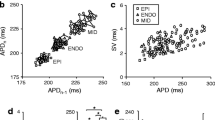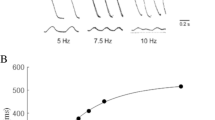Summary
One of the possible cellular mechanisms for certain types of ventricular arrhythmias is afterdepolarizations. There are two types of afterdepolarization. The delayed afterdepolarization (DAD) arises from the resting potential after full repolarization of an action potential and it may reach threshold for activation. It is favored by cellular Ca overload, and rapid preceding activation rates. The inward current generating the DAD is caused by one of two mechanisms: a Ca-dependent opening of non-specific cation channels, or Ca activation of a rheogenic Na/Ca exchange. The early afterdepolarization (EAD) arises on the shoulder of a preceding action potential plateau and it is favored by slow preceding activation rate and prolonged action potentials. Ca channels are usually responsible for the inward current for EAD’s, and cellular Ca overload is not related. These afterdepolarizations have characteristics that suggest their etiological role in certain arrhythmias found in heart failure.
Access this chapter
Tax calculation will be finalised at checkout
Purchases are for personal use only
Preview
Unable to display preview. Download preview PDF.
Similar content being viewed by others
References
Brachmann J, Scherlag BJ, Rosenshtraukh LV, Lazzara R (1983) Bradycardia dependent triggered activity: Relevance to drug-induced multiform ventricular tachycardia. Circulation 68:846–856
Bozler E (1943) The initiation of impulses in cardiac muscle. Am J Physiol 138:273–282
Cranefield PF (1977) Action potentials, afterpotentials, and arrhythmias. Circ Res 41:415–423
Davis LD (1973) Effects of changes in cycle length on diastolic depolarization produced by ouabain in canine Purkinje fibers. Circ Res 32:206–214
Ehara T, Noma A, Ono K (1988) Calcium-activated non-selective cation channel in ventricular cells isolated from adult guinea-pig hearts. J Physiol 403:117–133
Fabiato A (1985) Time and calcium dependence of activation and inactivation of calcium-induced release of calcium from the sarcoplasmic reticulum of a skinned canine cardiac Purkinje cell. J Gen Physiol 85:247–289
Ferrier GL, Saunders JH, Mendez C (1973) A cellular mechanism for the generation of ventricular arrhythmias by acetylstrophanthidin. Circ Res 32:600–689
Fozzard HA, January CT (1988) Delayed afterdepolarizations in heart muscle: Mechanisms and relevance. Pharmacol Rev 40:219–227
Hogan PM, Wittenberg SM, Klocke FJ (1973) Relationship of stimulation frequency to automaticity in the canine Purkinje fiber during ouabain administration. Circ Res 32:377–384
January CT, Riddle MJ (1989) Early afterdepolarizations: Mechanisms of induction and block; a role for L-type Ca++ current. Circ Res 64:977–990
January CT, Riddle M J, Salata JJ (1988) A model for early afterdepolarizations: Induction with the Ca2+ channel agonist Bay K 8644. Circ Res 62:563–571
Kimura J, Miyamae S, Noma A (1987) Identification of sodium-calcium exchange current in single ventricular cells of guinea-pig. J Physiol 387:199–222
Lederer WJ, Tsien RW (1976) Transient inward current underlying arrhythmogenic effects of cardiogenic steroids in Purkinje fibers. J Physiol 263:73–100
Marban E, Robinson SW, Wier GL (1986) Mechanisms of arrhythmogenic delayed and early afterdepolarizations in ferret ventricular muscle. J Clin Invest 78:1185–1192
Matsuda H, Noma A, Kirachi Y, Irisawa H (1982) Transient depolarization and spontaneous voltage fluctuations in isolated single cells from guinea-pig ventricles: calcium-mediated membrane potential fluctuations. Circ Res 51:142–151
Matsuda K, Hoshi T, Kameyama S (1959) Effects of aconitine on the cardiac membrane potential of the dog. Japanese J Physiol 9:419
Roden DM, Hoffman BF (1985) Action potential prolongation and induction of abnormal automaticity by low quinidine concentrations in canine Purkinje fibers. Relationship to potassium and cycle length. Circ Res 56:857–867
Rosen MR, Gelband HB, Hoffman FB (1973) Correlation between effects of ouabain on the canine electrocardiogram and transmembrane potentials of isolated Purkinje fibers. Circulation 47:65–72
Scherf D, Schott A (1973) Extrasystoles and allied arrhythmias. Heinemann, Chicago
Task Force of the Working group on Arrhythmias of the European society of Cardiology (1991) The Sicilian gambit. Circulation 84:1831–1851
Trautwein W (1970) Mechanisms of tachyarrhymias and extrasystoles. In: Sandoe E, Flenstad-Jenson E, Olesen K (eds) Symposium on cardiac arrhythmias. AB Astra, Sodertalje, Sweden, pp 53–66
Wier GL, Hess P (1984) Excitation-contraction coupling in cardiac Purkinje fibers: effects of cardiotonic steroids on the intracellular [Ca2+] transient, membrane potential, and contraction. J Gen Physiol 83:395–415
Wit AL, Rosen MR (1992) Afterdepolarizations and triggered activity distinction from automaticity as an arrhythmogenic mechanism. In: Fozzard HA, Haber E, Jennings RB, Katz AM, Morgan HE (eds) The heart and cardiovascular system, second edition. Raven Press, Ltd., New York, pp. 1–51
Wittenberg SM, Streuli F, Klocke FJ (1970) Acceleration of ventricular pacemakers by transient increases in heart rate in dogs during ouabain administration. Circ Res 26:705–716
Author information
Authors and Affiliations
Editor information
Editors and Affiliations
Rights and permissions
Copyright information
© 1992 Dr. Dietrich Steinkopff Verlag GmbH & Co. KG, Darmstadt
About this paper
Cite this paper
Fozzard, H.A. (1992). Afterdepolarizations and triggered activity. In: Holtz, J., Drexler, H., Just, H. (eds) Cardiac Adaptation in Heart Failure. Steinkopff. https://doi.org/10.1007/978-3-642-72477-0_10
Download citation
DOI: https://doi.org/10.1007/978-3-642-72477-0_10
Publisher Name: Steinkopff
Print ISBN: 978-3-642-72479-4
Online ISBN: 978-3-642-72477-0
eBook Packages: Springer Book Archive




